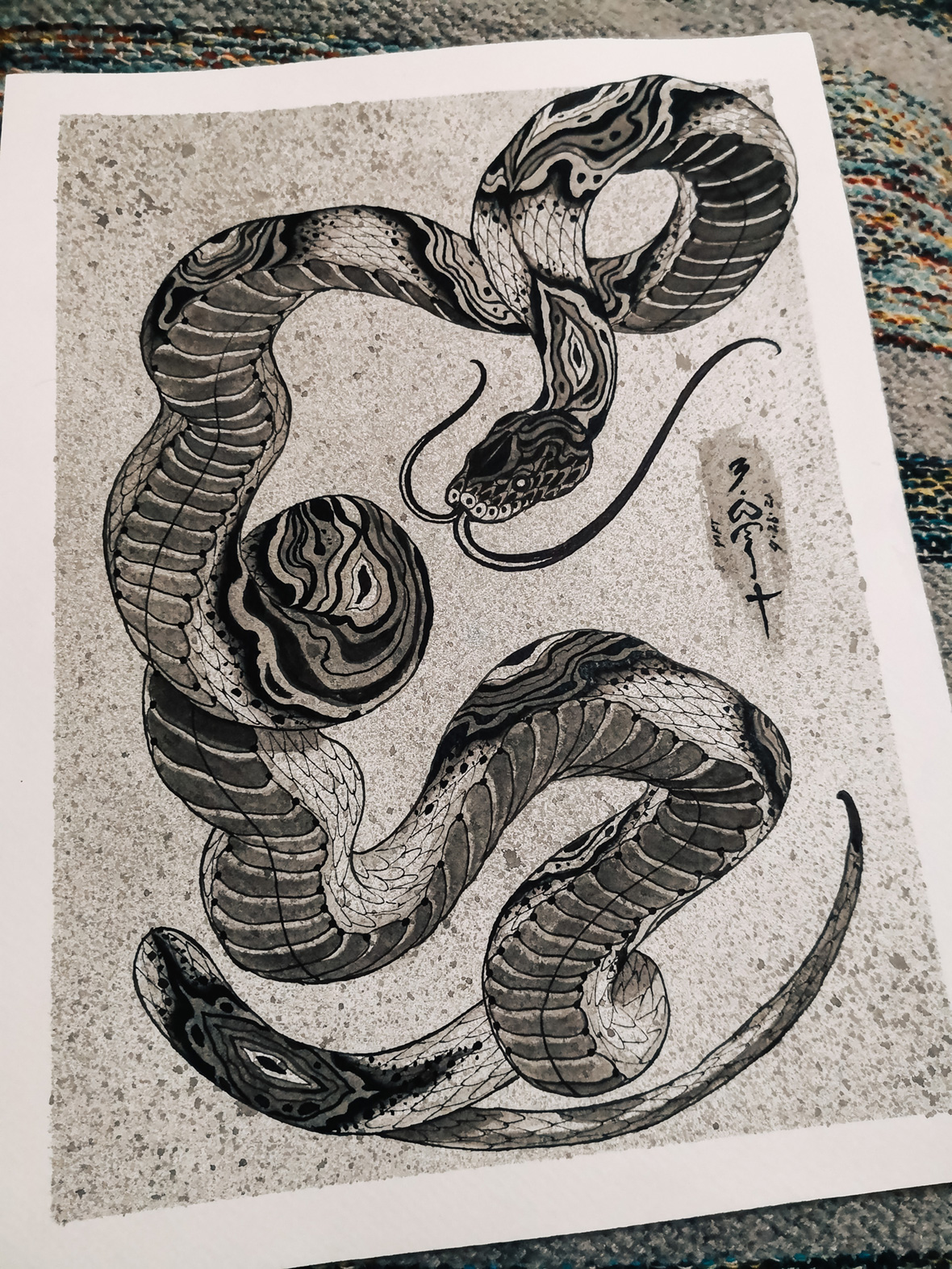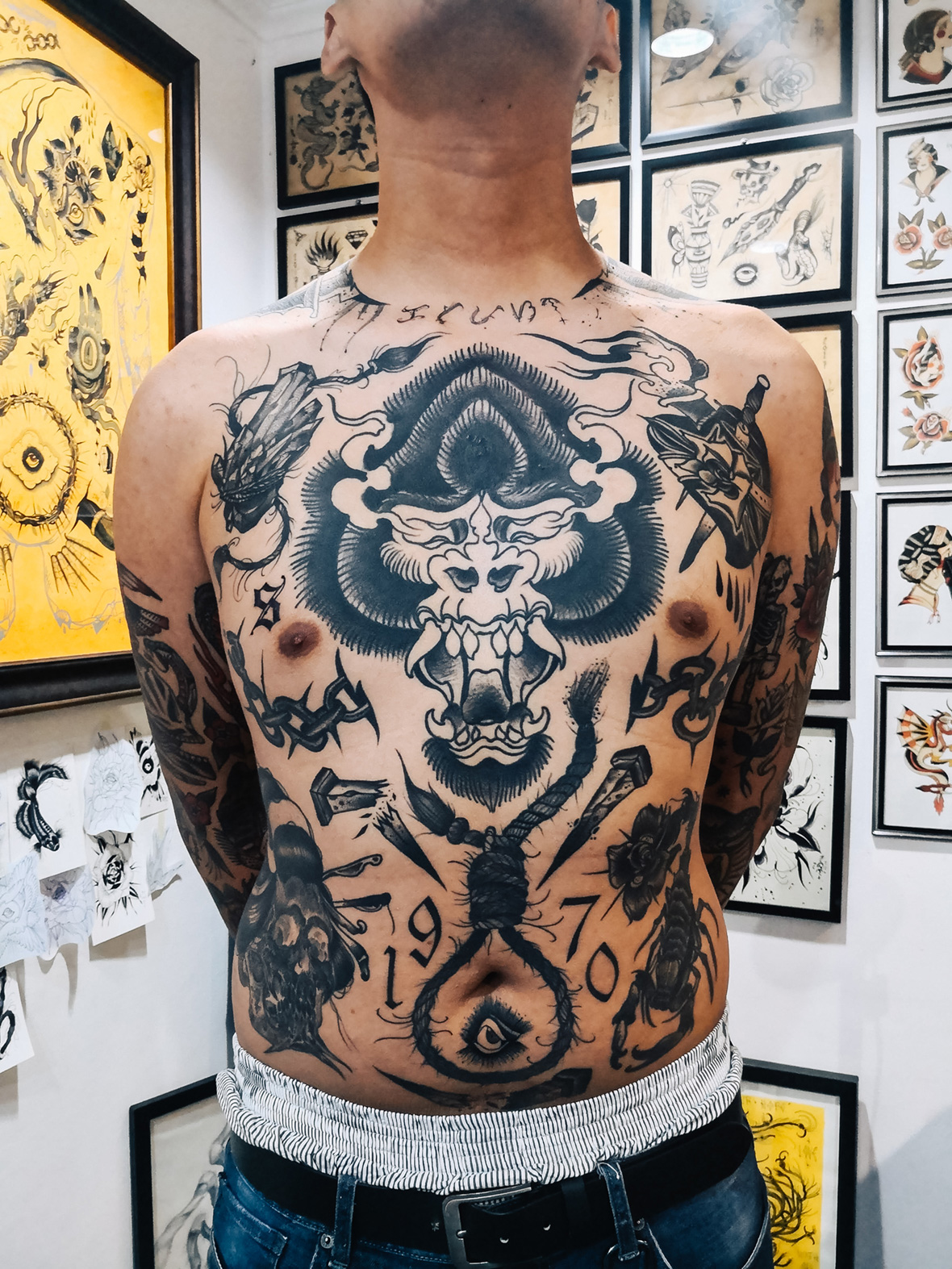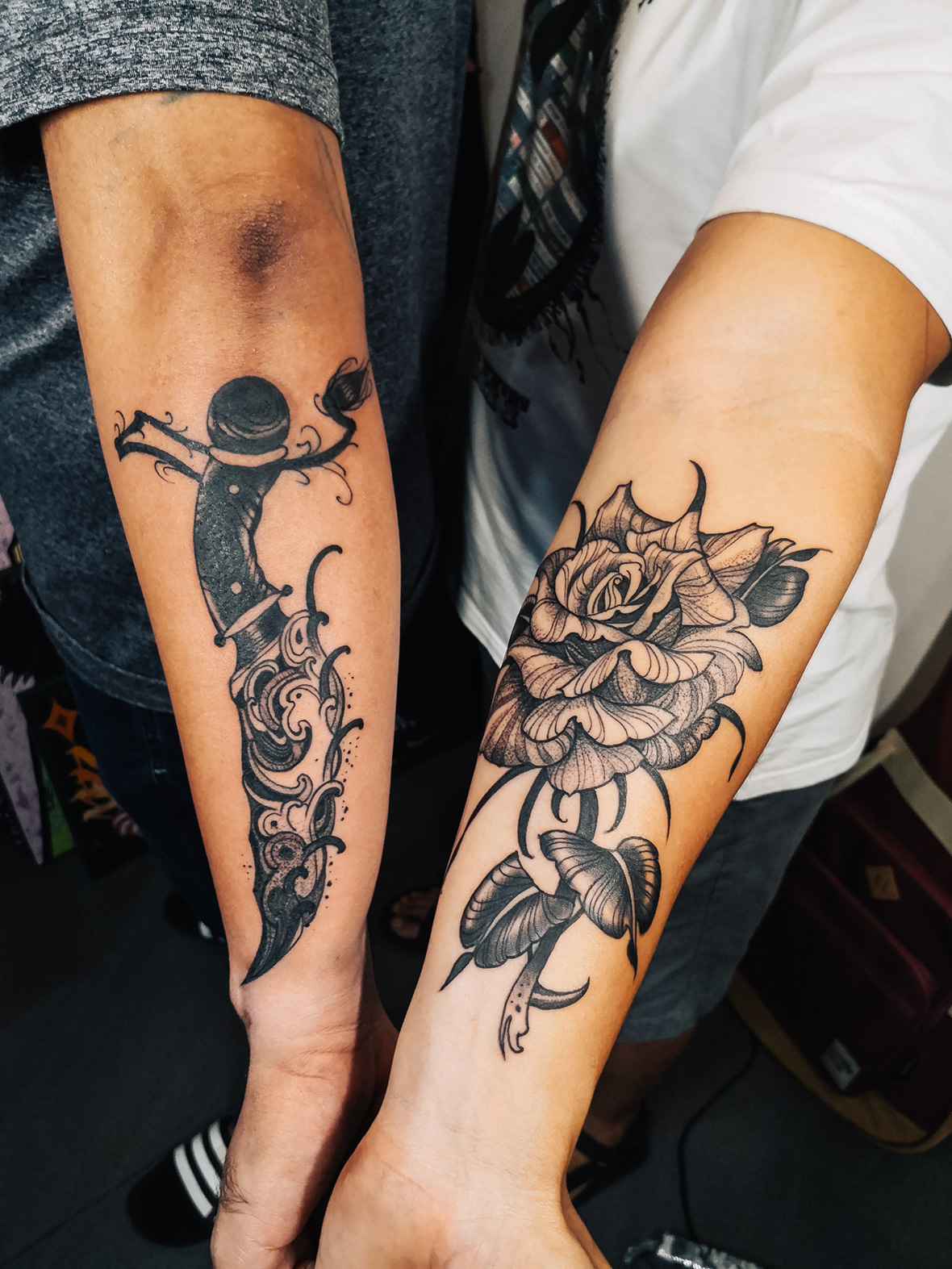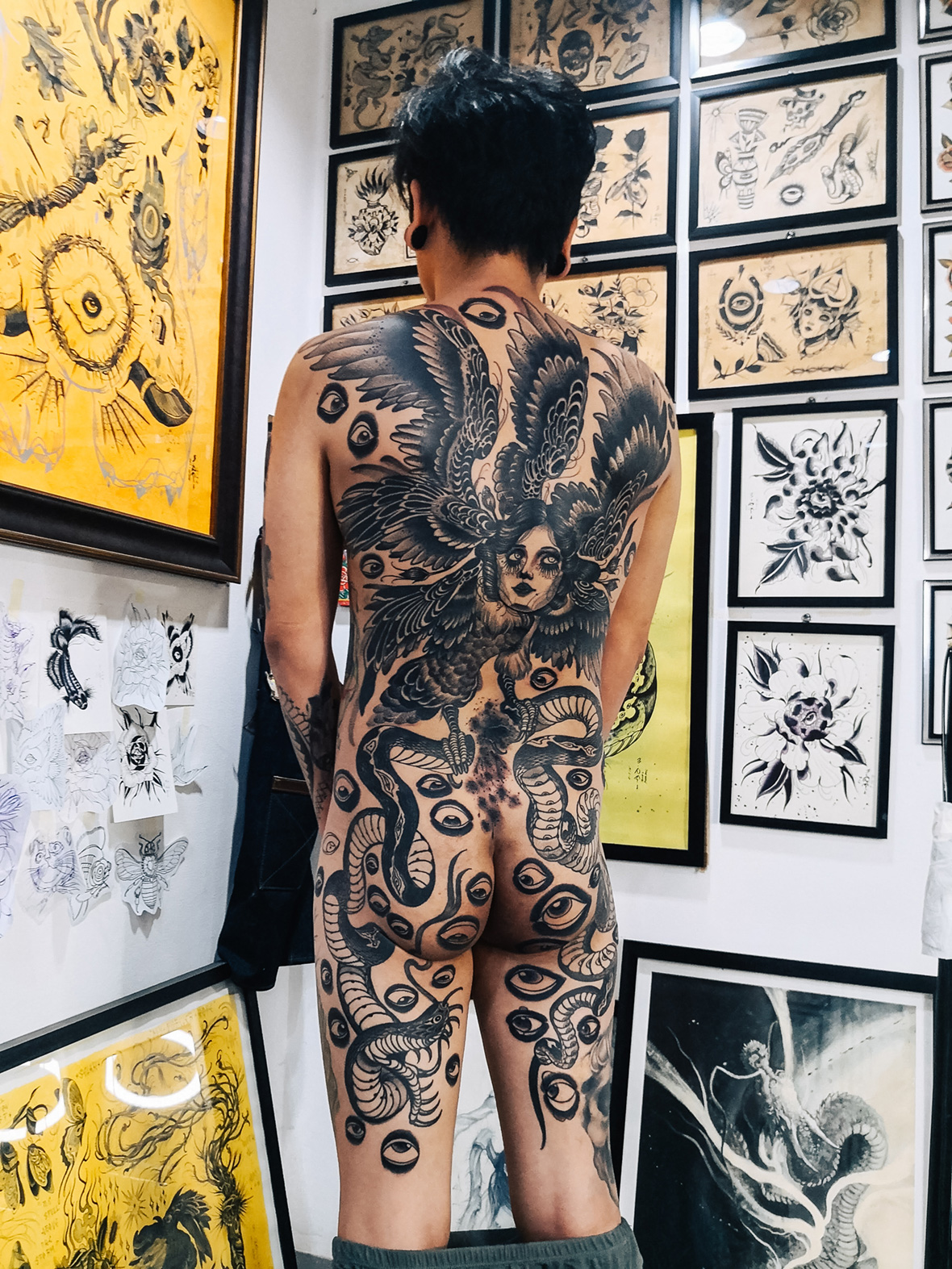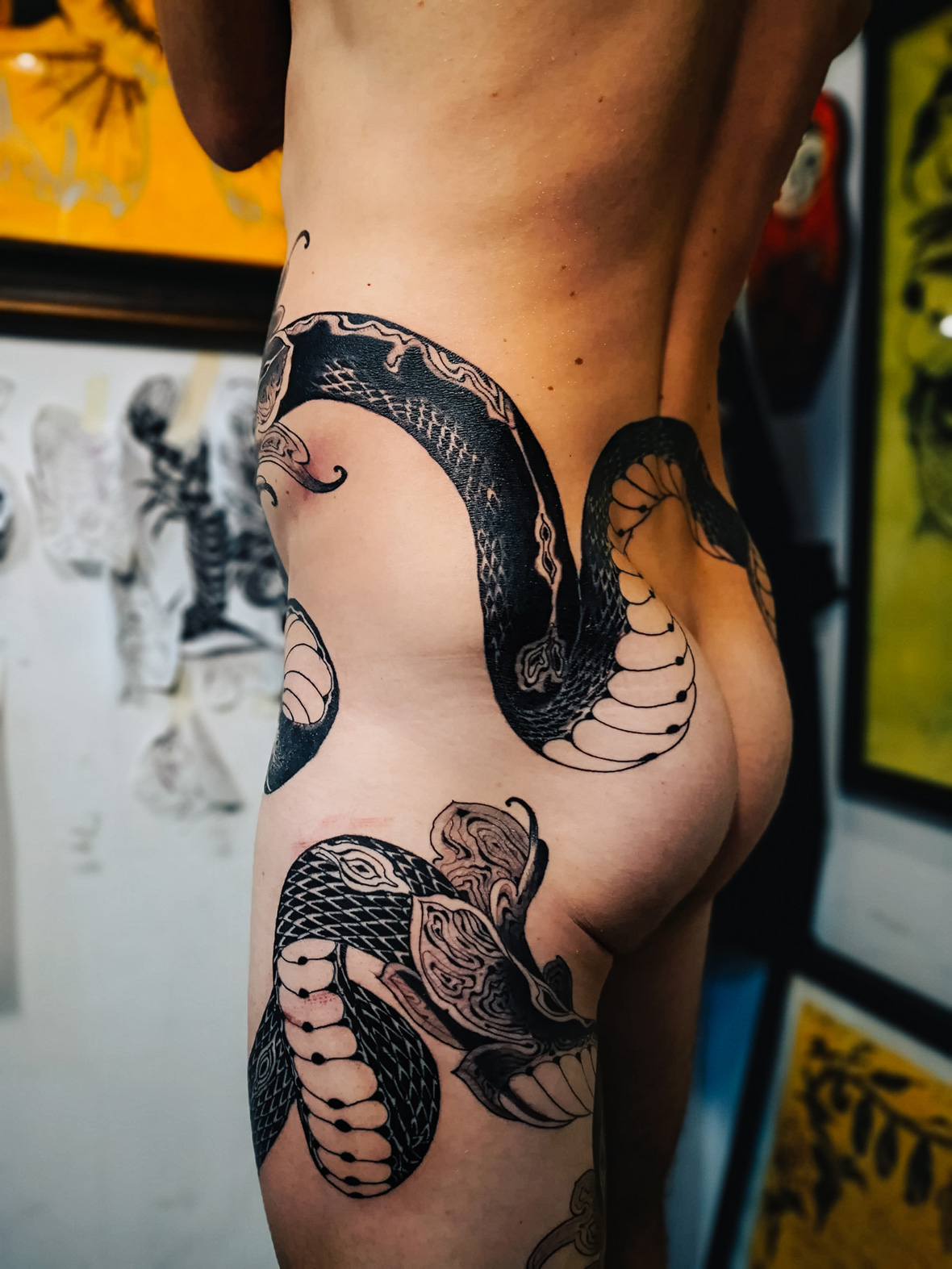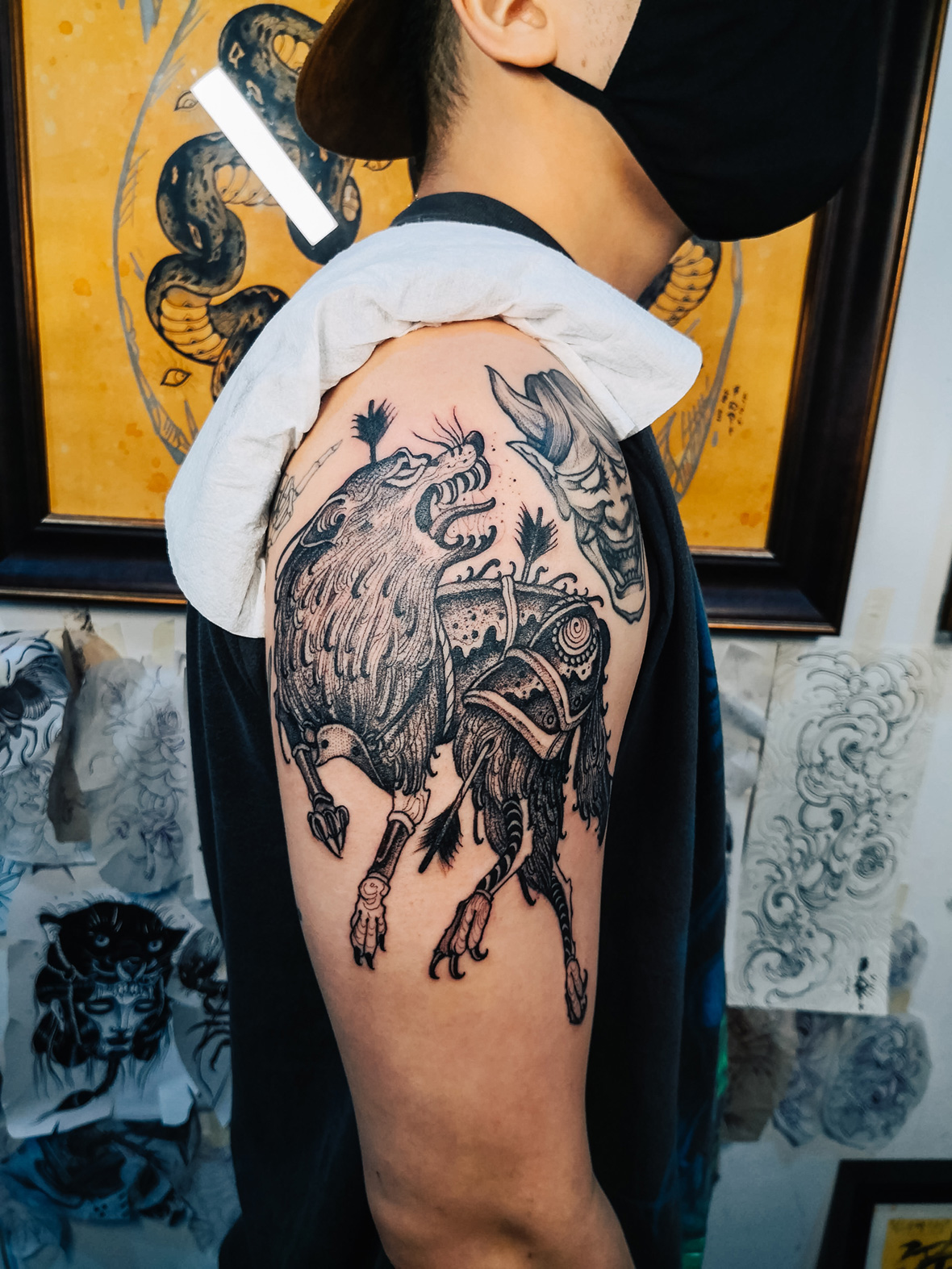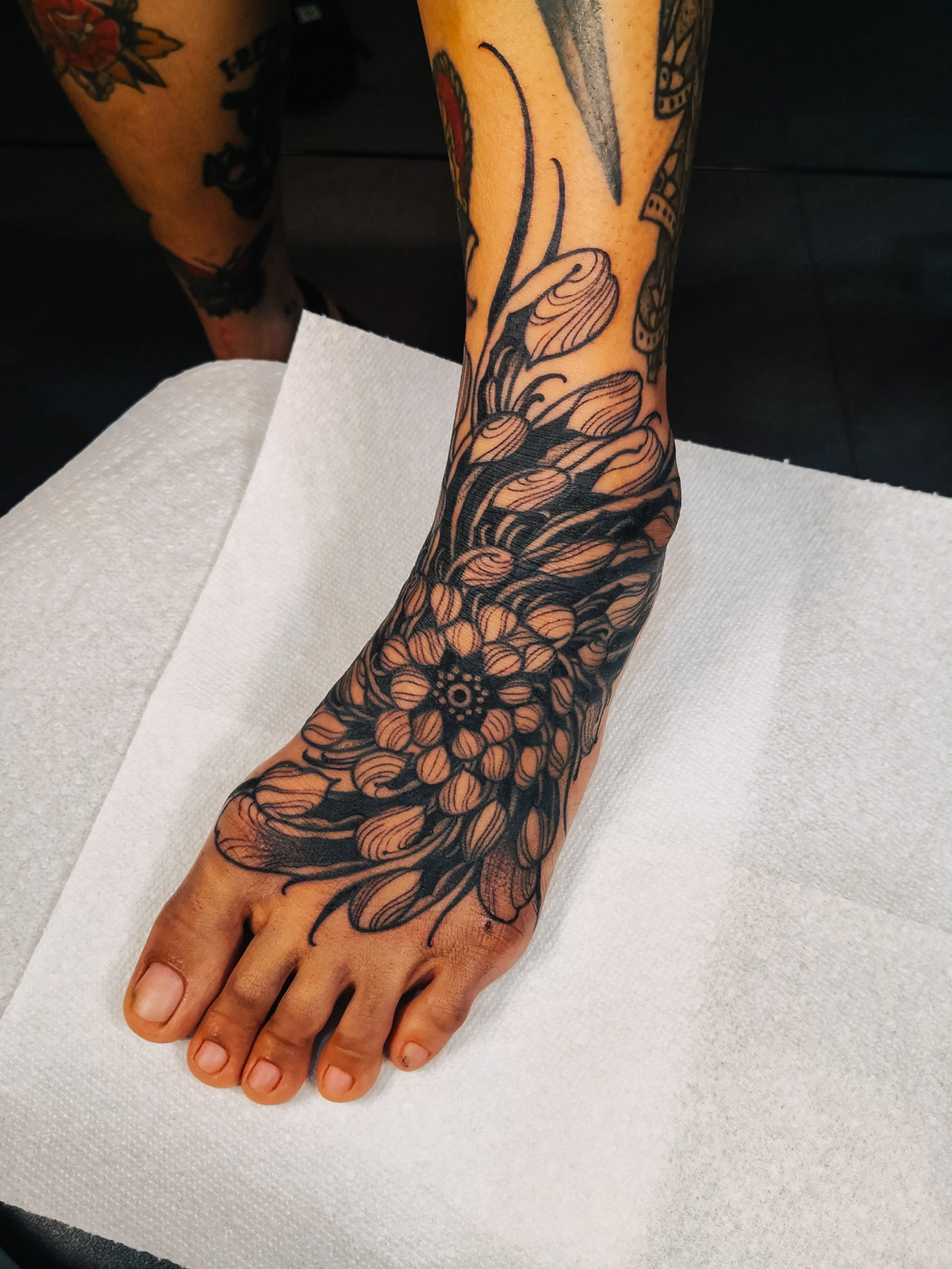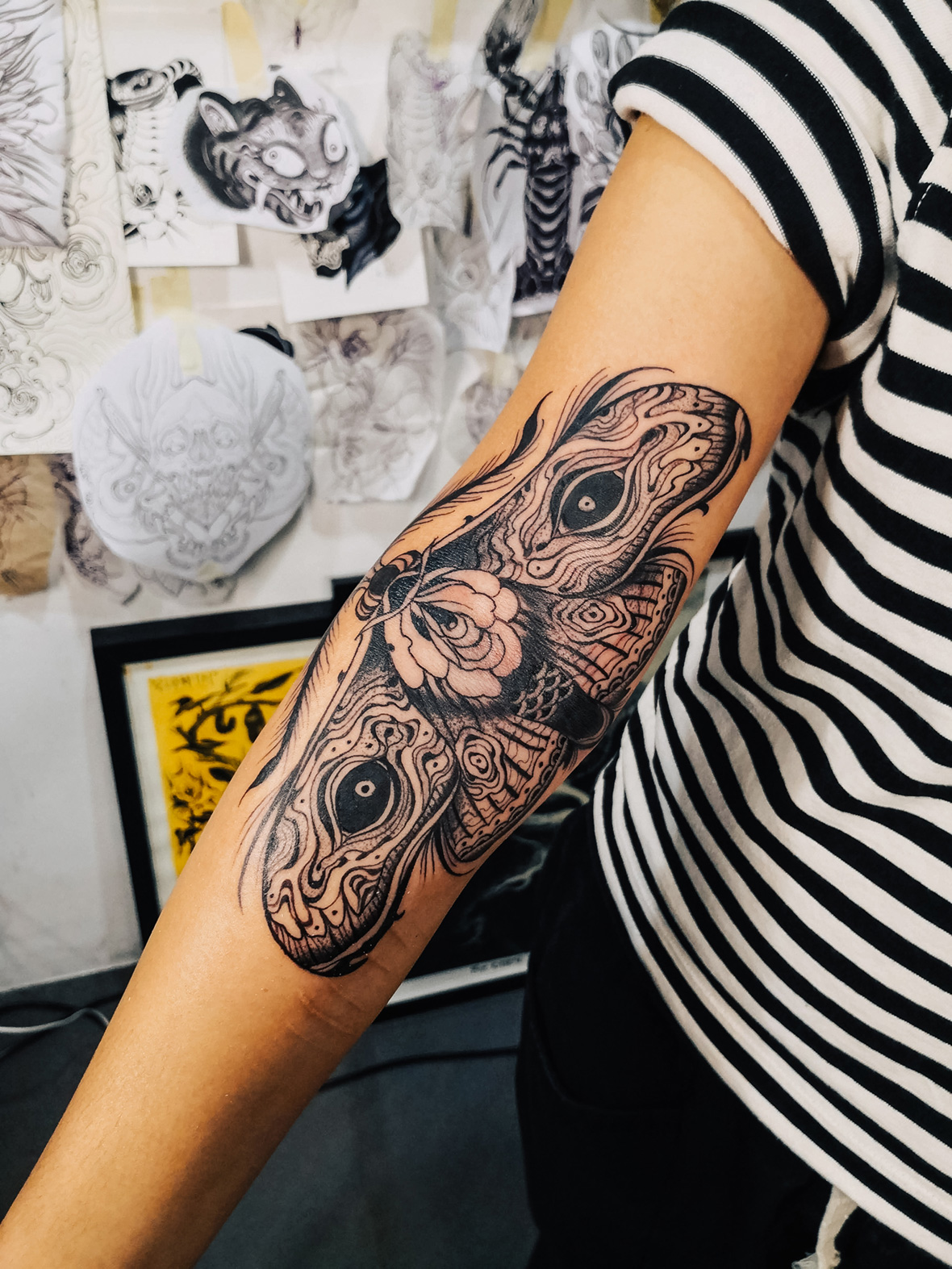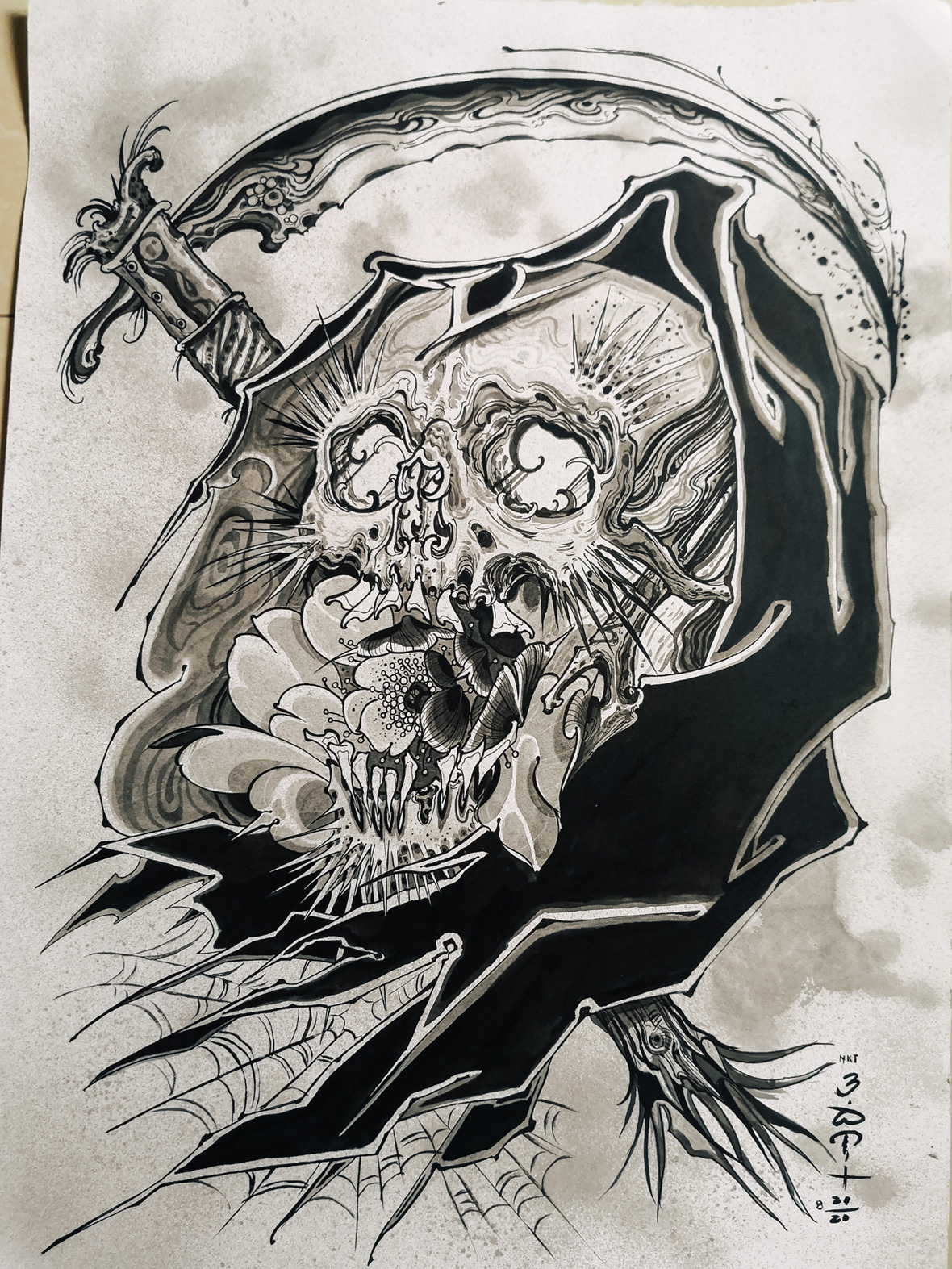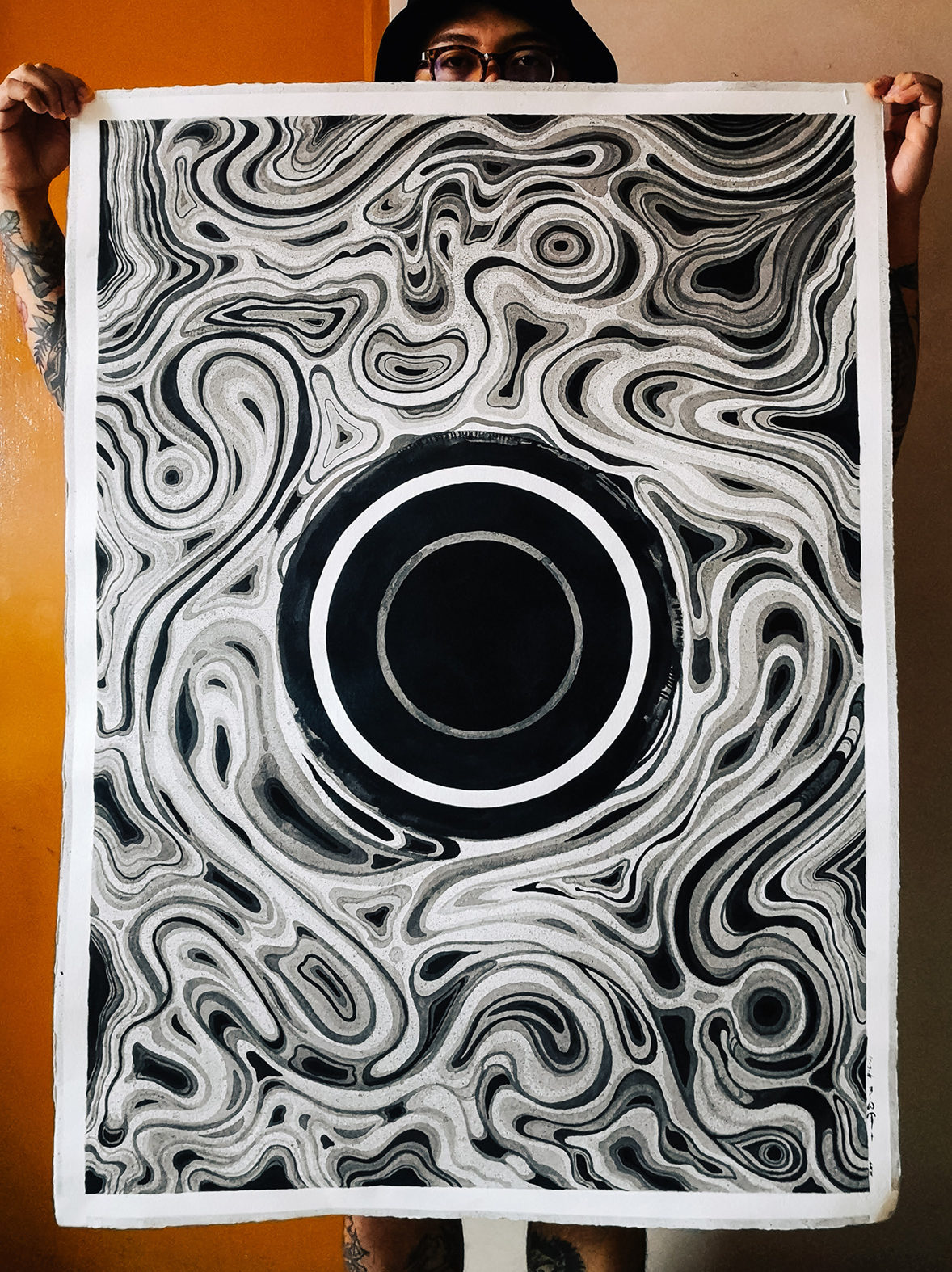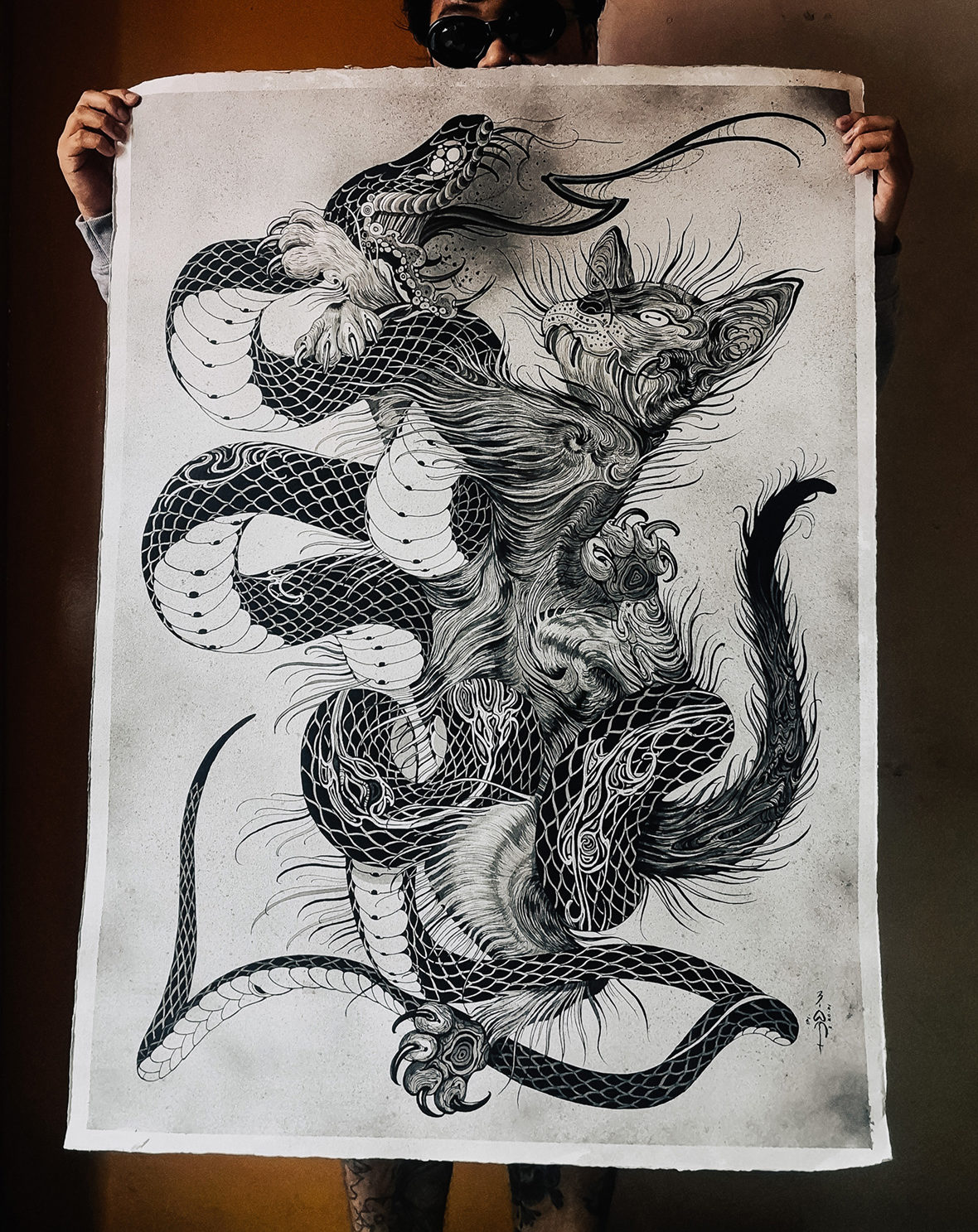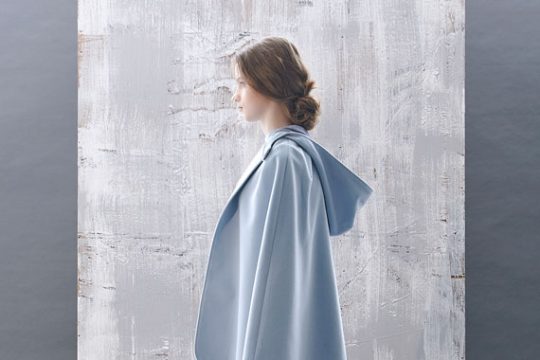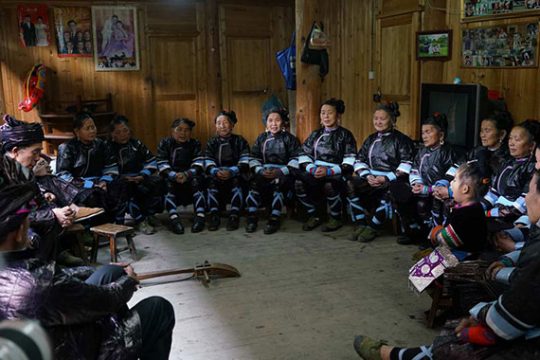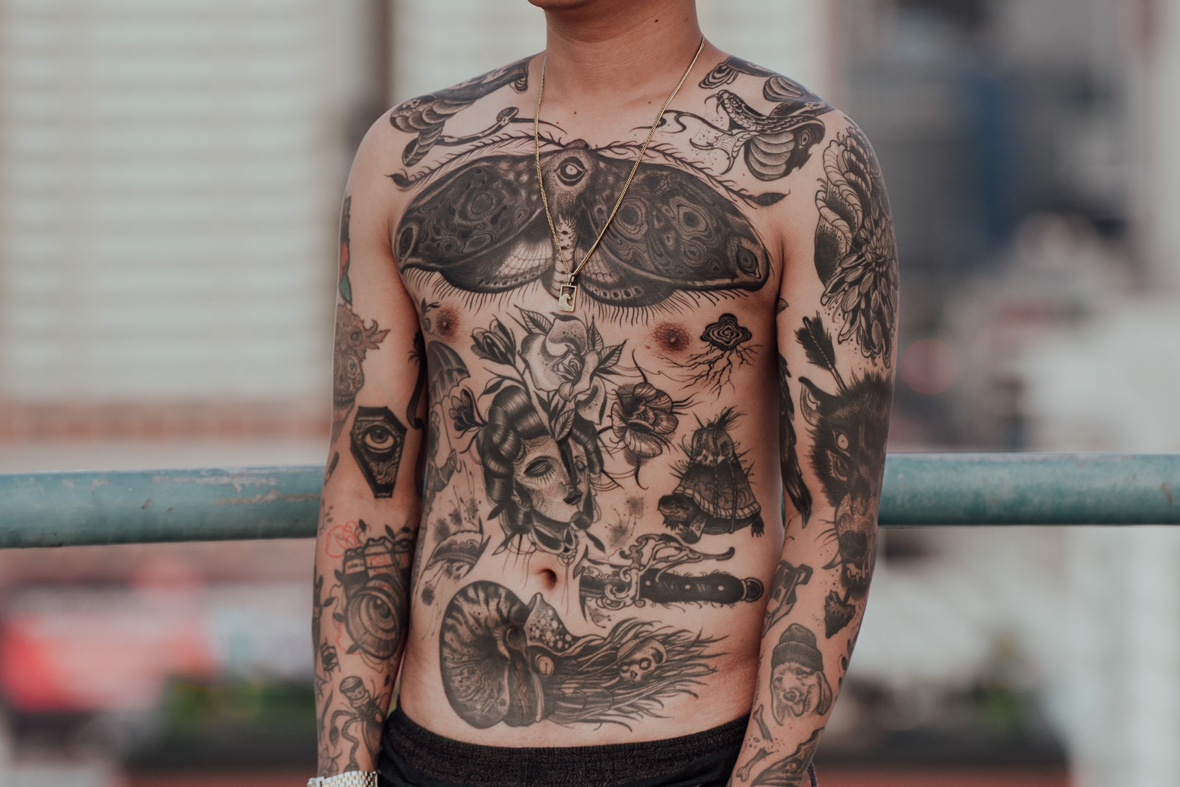
The style of Filipino artist Ruben Miralles is distinctly guided by his years of experience in the world of tattoos. But his aesthetic themes transfer well into the realm of fine art, as evidenced by a recent series of large-scale ink paintings. Japanese elements appear throughout, such as kaeru frogs and koi fish; traditional tattoo stalwarts like moths and ornate roses; illustrative flourishes of wisping wind and fluid clouds. These are all foundations of his work, which is a mashup of familiar references in neo-traditional, blackwork tattoo culture, all imbued with his personal touch. Everything is drawn with a sense of motion: insect wings flutter, flower petals drift in the wind, abstract shapes swirl and undulate, and his lines are bold like the impact of a rubber stamp.
菲律宾艺术家 Ruben Miralles 的绘画风格深受他多年纹身经验的指引,他能将自己那套纹身美学出色地移植在绘画领域。最近,他的一系列大型水墨画便是最佳的例证。从青蛙和锦鲤等日本元素、飞蛾和玫瑰等传统纹身图案,到逸风与流云的意象,这些元素共同构成了他绘画的基调。这种创作方式与传统纹身风格如出一辙,同时,Ruben 又能将动感的笔触融入其中:昆虫翅膀的颤动效果、随风飘扬的花瓣、抽象的形状旋转起伏,大胆粗野的线条如同刻章的纹路。
Miralles, who goes by the alias Oben, was interested in art as a kid, but he never thought about turning it into a career. Growing up in a low-income neighborhood in Taguig City, his parents hoped he would find a stable job in a more traditional industry. He’d been drawing as far back as he can remember and even had artsy side hustles throughout high school like drawing henna tattoos, which were trendy at the time. “My sister met some people working in booths selling henna tattoos along Roxas Boulevard back when it was still a popular area,” he recalls. “She brought a portfolio home for me to look at and I took it from there.”
Ruben 化名 Oben 进行创作,虽然自小就对艺术很感兴趣,但他从未想过有朝一日以此作为职业。他出生于达义市一个低收入社区,父母一直希望他能在传统行业找一份稳定的工作。他从小就开始画画,甚至在高中期间做了一些艺术相关的兼职,比如做纹身师,当时专心扎刻的是红极一时的海娜纹身。“我姐姐认识了一些在罗哈斯大道(Roxas Boulevard)摆摊画海娜纹身的人,这种纹身在当时相当火,”他回忆道,“她带了一些图片回家给我看,从那会儿开始接触纹身创作。”
Tattoos were an important part of some traditional Filipino cultures, but Western colonizers stigmatized them for centuries. And it took a while for contemporary tattoos to be embraced in the Philippines, largely because getting the necessary equipment was challenging. “In the ’90s it was really difficult to get decent needles, so artists would make their own,” Miralles says. “Now you can just click a button and get whatever you need in the mail.” There were still some subtle biases around tattoos as recently as a decade ago—if you were heavily inked in Manila, you may have trouble hailing a taxi late at night. But with the adaptation of the internet starting in the mid-2000s, the art form became more broadly accepted.
Miralles enrolled in college in 2008 with the goal of landing an office job, but was soon forced to drop out when his uncle ran out of money to help with tuition. It was then that Miralles turned his undivided attention to tattooing. He’d already been getting commissions for drawing realistic portraits, and after putting in significant time, effort, and a lengthy apprenticeship, he slowly found clients for tattoo work as well.
“I experimented a lot before landing on my current style,” he explains. “I really explore something fully before going for it. My mentality about drawing is that I try to achieve whatever the hardest aspect is. For example, I’d say realistic drawings are most difficult, so I focused on that first. After I’m happy with what I’ve tried to master, then I’ll break out of it and do something new, mixing together all the fundamentals I’ve learned to make my own version. I’m still learning and there are a lot of different categories of tattoos that are not easy.”
2008 年,Ruben 从高中毕业后进入大学,当时的他并没打算要将纹身作为自己的职业。他纯粹是想在大学期间找一份兼职,毕业后再好好找一份白领工作。但后来他叔叔的破产导致没办法再资助他的学费,于是 Ruben 才决定把纹身当成更认真的工作看待。后来经过大量的学习和练习纹身后,开始有客户找他纹身。
“在我找到自己现在的风格之前,我做了很多尝试,”他解释道,“我喜欢在开始之前先充分探索。对于绘画,我的想法是要先努力掌握最困难的部分。例如,我觉得写实绘画最难,那我就会先专攻这一块,直到我达到自己满意的水平后,再去尝试突破和创新,结合我所掌握的基础,转变成自己独特的风格。我还在不断学习,纹身也很多不同种类,有很多都充满了挑战性。”
While tattoos are now generally accepted in the Philippines, there are still gaps in knowledge, which can make it difficult to build a stable clientele. “When you’re pushing a specific style, you might only have specific clients,” Miralles says. “Most people bring an idea of what they want, like a picture of a loved one.” Although he has a steady customer base at his boutique reservation-only shop, it’s nothing like working in a street shop, where he could get up to nine walk-ins in a day. “At first it was really hard to get clients with my illustrative blackwork style, but eventually it grew. There’s still a lot of room for growth here.” He says that he put in a lot of work building a portfolio in the beginning, even doing free work just to have convincing examples for potential clients.
虽然现在的菲律宾社会对纹身的接受程度更高,但人们对纹身的认识仍然存在差距,因此很难建立稳定的客源。“当你强调一种特定风格时,也就只能吸引到特定的客户,大多数人来纹身时都已经有了自己的想法,比如要纹亲人的照片等等。”Ruben 说道。他现在的纹身店已经得到一帮固定的客源,但仍然无法和在街头摆摊时相提并论。在街边摆摊时,他一天最多可以有 9 个客户。他表示:“起初我的黑工纹身(blackwork style)作品风格很难吸引到客户,后面才有了越来越多的客户。其实增长空间还是很大的。”刚开始时,他很努力去丰富自己的作品,甚至提供免费纹身,目的就是为了吸引潜在客户。
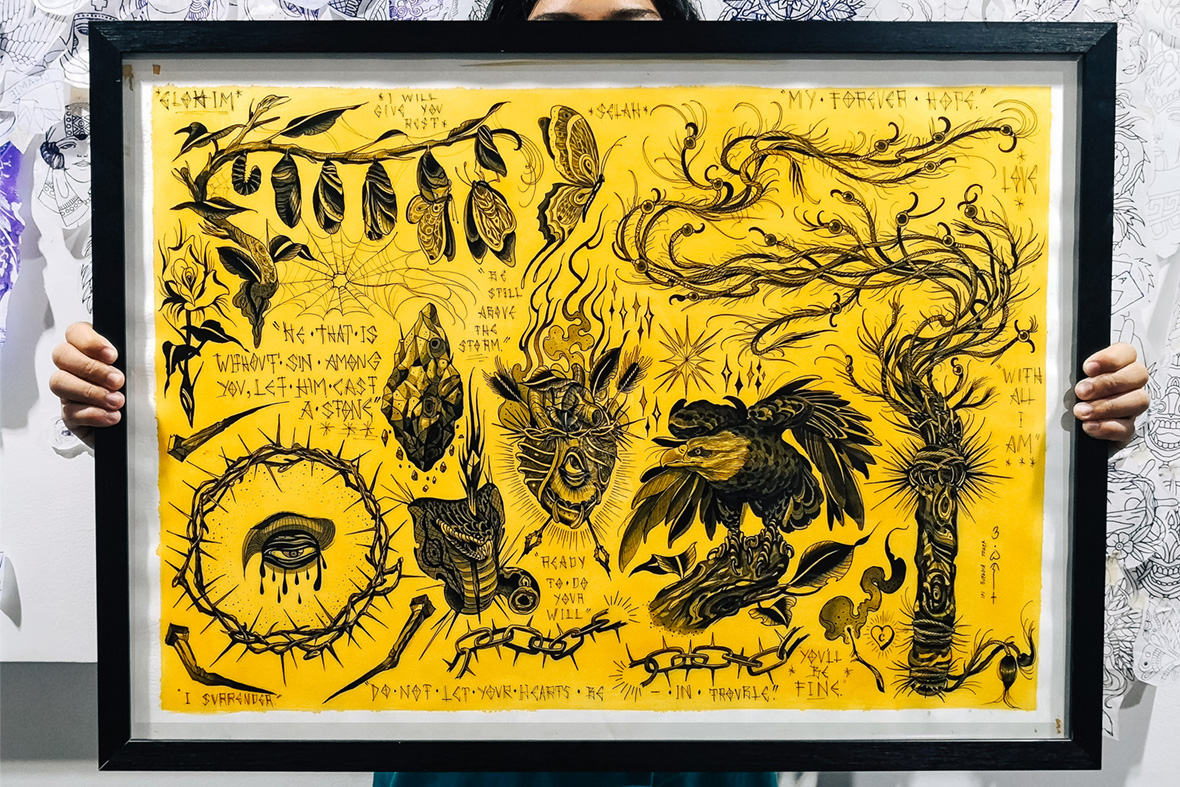
Recently, he’s started experimenting with ink paintings on watercolor paper. It’s still based on his blackwork tattoos, but these new works also include greys made by diluting ink and thinner lines drawn with a pen. It’s a clear effort to evolve artistically, part of his constant yearning to build on and grow from everything he’s learned along the way. While it’s very similar to his body art, on paper he has much more creative leeway and time to finetune details. “With tattoos, you often need to simplify a drawing to make it work,” Miralles says. “I usually tell my clients that I don’t refine my designs on paper, especially if it’s custom. I add most of the details to the skin. And if it’s large-scale, it could take months to finish.” But with paintings he can take his time; as long as he spends a couple of hours a day working on one, he’ll always be able to finish it. Miralles says that he was inspired to explore painting due to other tattoo artists online, and he says some local tattoo artists have taken his lead and tried the same. “That’s the prize right there. To inspire others. To elevate the culture.”
最近,他开始尝试用水彩纸创作水墨画。虽然这些新的作品仍然立足于他的黑工纹身作品,但多了一些由稀释墨水形成的灰色晕和钢笔细线。这是他在艺术创作上的努力突破,也是他一贯在创作上所追求的精益求精。虽然这与纹身很相似,但在纸上创作时,他可以有更多的创作余地,也有更多的时间来调整细节。Ruben 表示:“纹身的时候,往往需要简化设计图才行。我常常跟我的客户说,我不会在纸上去对我的设计精雕细琢,特别是对于定制的作品。我会直接在皮肤上添加细节。如果是大尺寸的纹身,可能需要几个月才能完成。”但画画的时候,他可以按照自己节奏慢慢来;只要每天花几个小时画一画,总有画完的一天。Ruben 表示自己开始画画也是受到网上其他纹身艺术家的启发。随后在他的影响下,当地一些纹身艺术家也开始尝试画画,“这就是一种收获。去激励他人,推动这种艺术的发展。”
Like our stories? Follow us on Facebook and Instagram.
Instagram: @obenism
Contributor: Mike Steyels
Chinese Translation: Olivia Li


